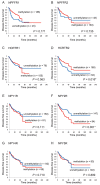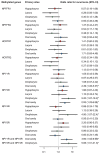Genes encoding neuropeptide receptors are epigenetic markers in patients with head and neck cancer: a site-specific analysis
- PMID: 29100314
- PMCID: PMC5652708
- DOI: 10.18632/oncotarget.19356
Genes encoding neuropeptide receptors are epigenetic markers in patients with head and neck cancer: a site-specific analysis
Abstract
Staging and pathological grading systems are useful but imperfect predictors of recurrence in head and neck squamous cell carcinoma (HNSCC). To identify potential prognostic markers, we examined the methylation status of eight neuropeptide receptor gene promoters in 231 head and neck squamous cell carcinomas. The NPFFR1, NPFFR2, HCRTR1, HCRTR2, NPY1R, NPY2R, NPY4R, and NPY5R promoters were methylated in 80.5%, 79.2%, 67.1%, 73.2%, 35.1%, 36.4%, 38.5%, and 35.9% of the samples, respectively. In a multivariate Cox proportional hazards analysis, the odds ratio for recurrence was 2.044 (95% confidence interval [CI], 1.323-3.156; P = 0.001) when the NPY2R promoter was methylated. In patients without lymph node metastasis (n = 100), methylation of NPY2R (compared with methylation of the other seven genes) best correlated with poor disease-free survival (DFS) (odds ratio, 2.492; 95% CI, 1.190-5.215; P = 0.015). In patients with oral cancer (n = 69), methylated NPY1R and NPY2R were independent prognostic factors for poor DFS, both individually and, even more so, in combination (odds ratio, 3.90; 95% CI, 1.523-9.991; P = 0.005). Similar findings were observed for NPY2R and NPY4R in patients with oropharyngeal cancer (n = 162) (odds ratio, 5.663; 95% CI, 1.507-21.28; P = 0.010).
Keywords: GPCR; epigenetic markers; head and neck cancer; metastases; neuropeptide receptors.
Conflict of interest statement
CONFLICTS OF INTEREST The authors have no conflicts of interest to declare.
Figures



Similar articles
-
The neuropeptide genes SST, TAC1, HCRT, NPY, and GAL are powerful epigenetic biomarkers in head and neck cancer: a site-specific analysis.Clin Epigenetics. 2018 Apr 11;10:52. doi: 10.1186/s13148-018-0485-0. eCollection 2018. Clin Epigenetics. 2018. PMID: 29682090 Free PMC article.
-
Neuropeptide receptor genes GHSR and NMUR1 are candidate epigenetic biomarkers and predictors for surgically treated patients with oropharyngeal cancer.Sci Rep. 2020 Jan 23;10(1):1007. doi: 10.1038/s41598-020-57920-z. Sci Rep. 2020. PMID: 31974445 Free PMC article.
-
Evaluation of epigenetic inactivation of vascular endothelial growth factor receptors in head and neck squamous cell carcinoma.Tumour Biol. 2017 Jul;39(7):1010428317711657. doi: 10.1177/1010428317711657. Tumour Biol. 2017. PMID: 28718364
-
Bioinformatic analysis of neuropeptide related genes in patients diagnosed with invasive breast carcinoma.Comput Biol Med. 2024 Dec;183:109304. doi: 10.1016/j.compbiomed.2024.109304. Epub 2024 Oct 21. Comput Biol Med. 2024. PMID: 39437604
-
The prognostic role of the cancer stem cell marker aldehyde dehydrogenase 1 in head and neck squamous cell carcinomas: a meta-analysis.Oral Oncol. 2014 Dec;50(12):1144-8. doi: 10.1016/j.oraloncology.2014.08.018. Epub 2014 Sep 26. Oral Oncol. 2014. PMID: 25264224 Review.
Cited by
-
Prostanoid receptor genes confer poor prognosis in head and neck squamous cell carcinoma via epigenetic inactivation.J Transl Med. 2020 Jan 21;18(1):31. doi: 10.1186/s12967-020-02214-1. J Transl Med. 2020. PMID: 31969157 Free PMC article.
-
The Novel Methylation Biomarker NPY5R Sensitizes Breast Cancer Cells to Chemotherapy.Front Cell Dev Biol. 2022 Jan 11;9:798221. doi: 10.3389/fcell.2021.798221. eCollection 2021. Front Cell Dev Biol. 2022. PMID: 35087836 Free PMC article.
-
Chronic Inhalation Exposure to Antimony Trioxide Exacerbates the MAPK Signaling in Alveolar Bronchiolar Carcinomas in B6C3F1/N Mice.Toxicol Pathol. 2023 Jan;51(1-2):39-55. doi: 10.1177/01926233231157322. Epub 2023 Apr 3. Toxicol Pathol. 2023. PMID: 37009983 Free PMC article.
-
Genes Located on 18q23 Are Epigenetic Markers and Have Prognostic Significance for Patients with Head and Neck Cancer.Cancers (Basel). 2019 Mar 21;11(3):401. doi: 10.3390/cancers11030401. Cancers (Basel). 2019. PMID: 30901947 Free PMC article.
-
The GAL/GALR2 axis promotes the perineural invasion of salivary adenoid cystic carcinoma via epithelial-to-mesenchymal transition.Cancer Med. 2023 Feb;12(4):4496-4509. doi: 10.1002/cam4.5181. Epub 2022 Aug 29. Cancer Med. 2023. PMID: 36039037 Free PMC article.
References
-
- Parkin DM, Bray F, Ferlay J, Pisani P. Global cancer statistics, 2002. CA Cancer J Clin. 2005;55:74–108. - PubMed
-
- Pai SI, Westra WH. Molecular pathology of head and neck cancer: implications for diagnosis, prognosis, and treatment. Annu Rev Pathol. 2009;4:49–70. https://doi.org/10.1146/annurev.pathol.4.110807.092158. - DOI - PMC - PubMed
-
- Kanazawa T, Misawa K, Misawa Y, Uehara T, Fukushima H, Kusaka G, Maruta M, Carey TE. G-protein-coupled receptors: next generation therapeutic targets in head and neck cancer? Toxins (Basel) 2015;7:2959–84. https://doi.org/10.3390/toxins7082959. - DOI - PMC - PubMed
-
- Bar-Shavit R, Maoz M, Kancharla A, Nag JK, Agranovich D, Grisaru-Granovsky S, Uziely B. G protein-coupled receptors in cancer. Int J Mol Sci. 2016:17. https://doi.org/10.3390/ijms17081320. - DOI - PMC - PubMed
-
- Munk C, Isberg V, Mordalski S, Harpsoe K, Rataj K, Hauser AS, Kolb P, Bojarski AJ, Vriend G, Gloriam DE. GPCRdb: the G protein-coupled receptor database - an introduction. Br J Pharmacol. 2016;173:2195–207. https://doi.org/10.1111/bph.13509. - DOI - PMC - PubMed
LinkOut - more resources
Full Text Sources
Other Literature Sources

